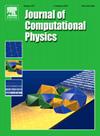The KAN-MHA model: A novel physical knowledge based multi-source data-driven adaptive method for airfoil flow field prediction
IF 3.8
2区 物理与天体物理
Q2 COMPUTER SCIENCE, INTERDISCIPLINARY APPLICATIONS
引用次数: 0
Abstract
The power generation efficiency and operational safety of wind turbines depend heavily on the aerodynamic performance of their airfoils, which is primarily controlled by the flow field. Traditional methods for predicting this flow field rely on solving the Navier-Stokes (NS) equations, which are computationally expensive and inefficient. To address these challenges, this paper proposes a novel neural network model, the KAN-MHA, which integrates a Kolmogorov-Arnold Network (KAN) with a Multi-Head Attention (MHA) mechanism, leveraging multi-source datasets that include wind tunnel experiments, XFoil results, and CFD simulations. By incorporating physical constraints, the KAN-MHA model achieves precise predictions of flow fields with a simpler architecture and reduced computational cost. Experimental results indicate that, compared to traditional multilayer perceptron (MLP) networks, the KAN-MHA model achieves a substantial reduction in testing loss, while maintaining a significantly simpler architecture with fewer neurons. Through an analysis of the attention weights in the MHA mechanism, we found that MHA effectively guides the network to focus on regions with more intricate flow variations, thereby enhancing the model's ability to capture subtle flow field features with higher accuracy. As a result, the model demonstrates excellent prediction performance for aerodynamic coefficients and effectively identifies stall behavior in airfoils at high angles of attack. This work provides a novel approach for the design and optimization of wind turbine airfoils, offering valuable insights for enhancing aerodynamic performance under complex flow conditions.

求助全文
约1分钟内获得全文
求助全文
来源期刊

Journal of Computational Physics
物理-计算机:跨学科应用
CiteScore
7.60
自引率
14.60%
发文量
763
审稿时长
5.8 months
期刊介绍:
Journal of Computational Physics thoroughly treats the computational aspects of physical problems, presenting techniques for the numerical solution of mathematical equations arising in all areas of physics. The journal seeks to emphasize methods that cross disciplinary boundaries.
The Journal of Computational Physics also publishes short notes of 4 pages or less (including figures, tables, and references but excluding title pages). Letters to the Editor commenting on articles already published in this Journal will also be considered. Neither notes nor letters should have an abstract.
 求助内容:
求助内容: 应助结果提醒方式:
应助结果提醒方式:


